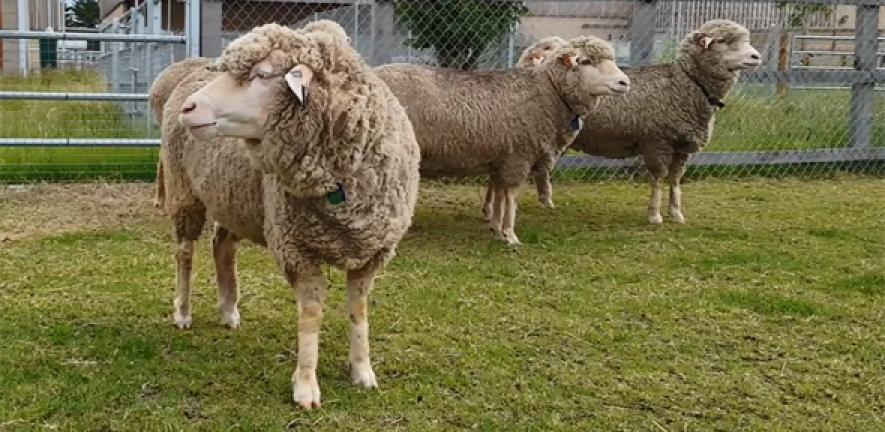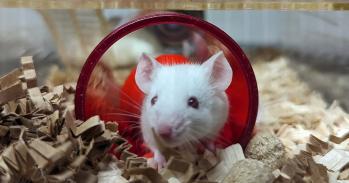
Scientists at the University of Cambridge will this week begin studying sheep that have been genetically modified to carry the mutation that causes Huntington’s disease. The sheep are believed to be the first Merinos to have been imported into the UK from Australia for about 50 years.
Scientists at the University of Cambridge will this week begin studying sheep that have been genetically modified to carry the mutation that causes Huntington’s disease. The sheep are believed to be the first Merinos to have been imported into the UK from Australia for about 50 years.
Even though we’ve known for decades now exactly which genetic mutation causes Huntington’s disease, we’re arguably still no nearer a cure – the best we can do is manage the symptoms
Jenny Morton
Huntington’s disease affects more than 6,700 people in the UK. It is an incurable neurodegenerative disease. It is typically an adult-onset disease, although there is a juvenile form. Initially, the disease affects motor coordination, mood, personality and memory, but then leads to difficulty in speech and swallowing, loss of motor function and death at a relatively early age. There is no known cure for the disease, only ways to manage the symptoms.
The disease is caused by a mutation in the genetic code in the huntingtin (HTT) gene. Genetic information is coded in DNA that is made up of a repeated string of four molecules known as nucleotides, or bases – A, C, G and T. The HTT gene contains a repeated string of CAG bases: in healthy individuals, the CAG repeat is around 20 CAGs long, but if the repeat has 36 or more CAGs, an individual will develop Huntington’s disease.
The Huntington’s disease sheep were developed in 2006 by a team led by Professor Sir Richard Faull and Professor Russell Snell from the University of Auckland, New Zealand. Together with colleagues in Australia, they successfully bred a strain of Merino sheep carrying the human genetic mutation that causes Huntington's disease in patients. While mice and rats are used in the vast majority of disease studies in the UK, the sheep is an important new animal model for Huntington’s disease. Not only do sheep live much longer than rodents, but also sheep brains are larger and closer in size and structure to humans.
The Cambridge research will be led by Professor Jenny Morton from the Department of Physiology, Development and Neuroscience. “Even though we’ve known for decades now exactly which genetic mutation causes Huntington’s disease, we’re arguably still no nearer a cure – the best we can do is manage the symptoms,” she says. “Even those treatments are limited to some of the motor symptoms.”
The sheep model is particularly important, because until recently, scientists have been unable to model the disease in longer-living animals. This matters because the symptoms of Huntington’s rarely appear before adulthood; sheep can live for at least 10-12 years, which gives a much wider window of opportunity for studying the disease than is possible in mice.
“It has taken our collaborators in Australia years of research to develop these sheep, but we’re already beginning to get insights into how the disease progresses, particularly before symptoms become apparent,” says Professor Morton.
The Huntington’s disease sheep are already proving their value. Although even up to the age of nine years they look completely normal, the researchers have observed some interesting progressive behavioural changes. In addition, a study led by Professor Morton published earlier this year in Scientific Reports used the Huntington’s disease sheep in Australia to identify early biomarkers of disease: changes in metabolites in blood taken from sheep at a pre-symptomatic stage of the disease showed that Huntington’s disease affects important metabolic processes in the body prior to the appearance of physical symptoms.
Until 2014, it was not possible to import live sheep from Australia to the UK. However, changes in regulations allowed Professor Morton to import the Huntington’s disease sheep. The first sheep were imported earlier this year, but have only just been released from quarantine.
“We have done many experiments using the sheep in Australia over the past seven years, and we will continue to use them there,” says Professor Morton. “However, we cannot do some of the more technically demanding experiments, or behavioural studies that take a long time, on field trips. We have excellent animal facilities in Cambridge and so are in a good position to do the long term behavioural monitoring that will help us understand how the neurological symptoms develop.”
The imported sheep will be used to study brain and behavioural changes that cause Huntington’s disease, with a particular emphasis on understanding the cognitive decline. Professor Morton has developed a number of tests that can be used for measuring learning and memory in sheep. These have been based on the tests used for monitoring symptom progression in patients with Huntington’s disease. By using tests similar to those used in patients, she hopes that the findings from the sheep studies can be ‘translated’ directly back to humans. Once they have the basic measures established, they will begin testing novel therapies in the Huntington’s disease sheep.
“These sheep will be invaluable to us in our search for a better understanding of Huntington’s disease, so we are grateful to the authorities for allowing them to be imported,” says Professor Morton. “We hope in future to be able to breed these sheep here, rather than having to import them, but we know that even getting to the stage of breeding them in Australia has been a challenge for the team there.”

The text in this work is licensed under a Creative Commons Attribution 4.0 International License. For image use please see separate credits above.




